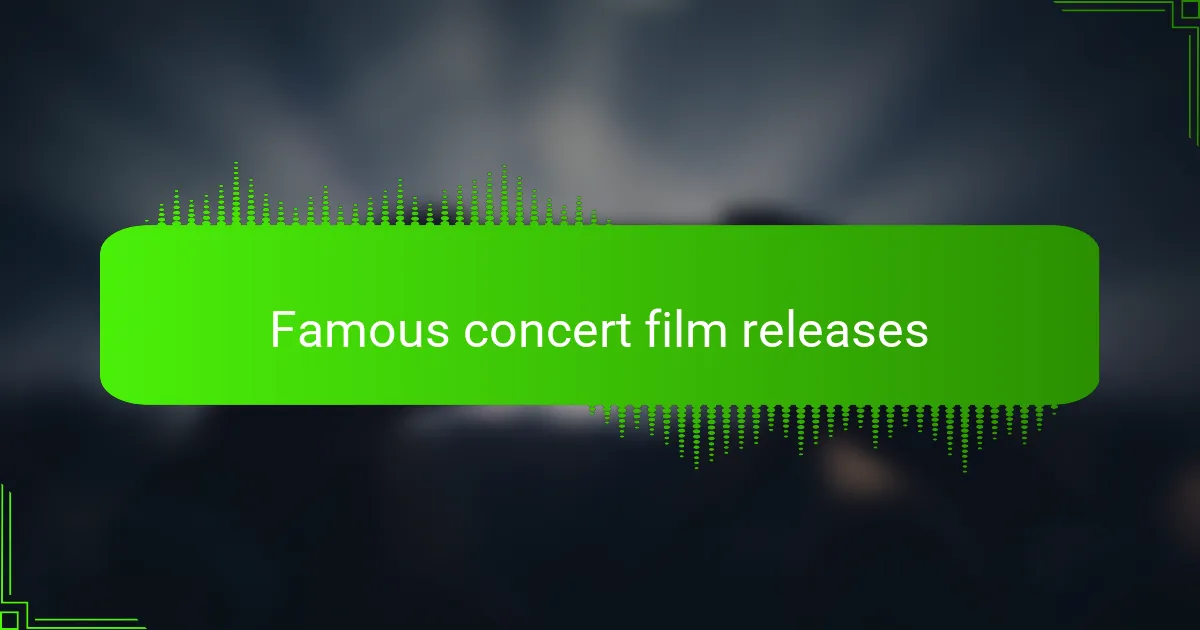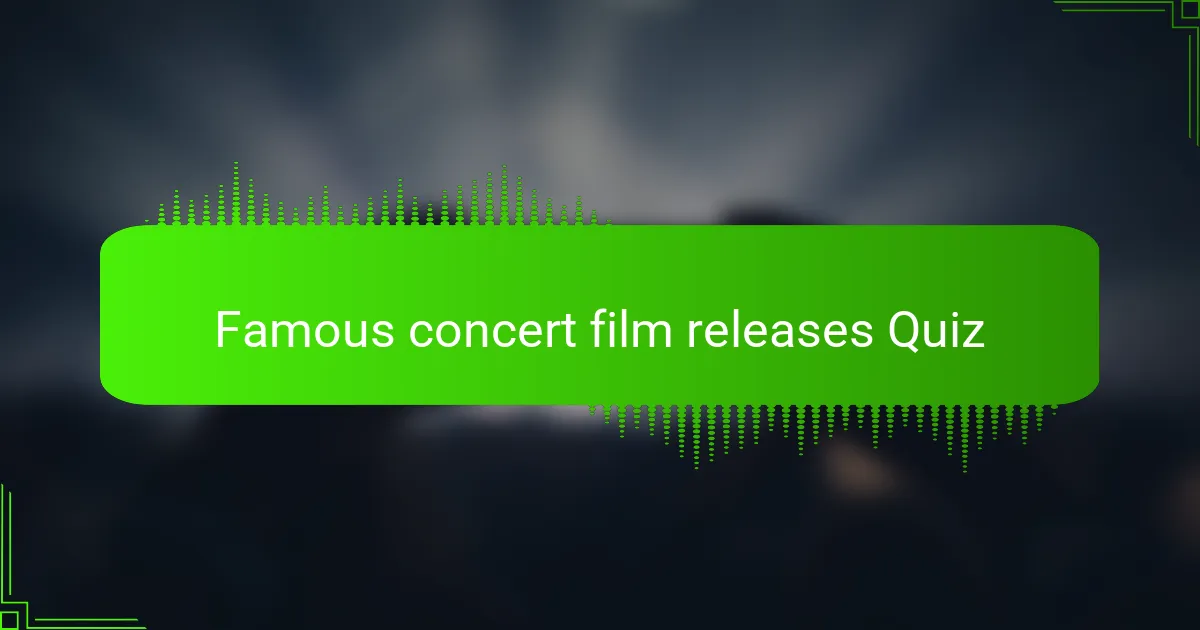
Quiz Completed: Celebrate Your Knowledge on Famous Concert Films!
Congratulations on completing the quiz about famous concert film releases! We hope you found the questions enlightening and that they sparked your appreciation for the artistry captured in these captivating films. From the iconic performances to the unique storytelling methods that bring music to life on screen, each film has its own magic and history. Understanding this adds another layer of enjoyment to the music we love.
As you navigated through the quiz, you likely discovered some intriguing facts about your favorite artists and their contributions to concert cinematography. It’s fascinating to learn how these films have influenced both fans and musicians alike. Whether it was the way a film captured the energy of a live performance or showcased behind-the-scenes glimpses, each concert film opens a new doorway into the world of music.
If you’re eager to dive deeper into this topic, we invite you to check out the next section on our page, dedicated to famous concert film releases. You’ll find detailed insights, behind-the-scenes stories, and recommendations that will further enhance your understanding and appreciation of this unique genre. Keep exploring, and let the music inspire you!

Famous concert film releases
The Evolution of Concert Films
Concert films have transformed significantly since the mid-20th century. Initially, they were simple recordings of performances, often lacking artistic direction. One pivotal concert film is “Woodstock” (1970), which captured the iconic festival, blending music with cultural context. As technology advanced, so did the artistry. Films like “Stop Making Sense” (1984) by the Talking Heads innovated the genre with dynamic visual storytelling. Today, concert films integrate high-definition imaging and surround sound, exemplified by “Homecoming” (2019) featuring Beyoncé. These advancements create immersive experiences, appealing to broader audiences.
Iconic Concert Film Releases
Several concert films have achieved legendary status. “The Last Waltz” (1978) directed by Martin Scorsese chronicles The Band’s farewell concert. It features renowned artists like Bob Dylan and Eric Clapton, making it a cultural hallmark. Another notable release is “Live Aid” (1985), showcasing performances from Queen and U2. This film highlights the power of music for humanitarian causes. “This Is It” (2009) captures Michael Jackson’s rehearsals for his concert series, demonstrating his artistry and enthusiasm. Each of these films embodies the spirit of live music and its impact on audiences globally.
Notable Acts in Concert Films
Various artists have become synonymous with groundbreaking concert films. Madonna’s “Truth or Dare” (1991) redefined the genre, blending documentary and performance art. It showcased her “Blonde Ambition World Tour,” revealing the intimate connection between the artist and her fans. Similarly, “Glastonbury” (2006) features performances by prominent acts like Coldplay and Muse. The film encapsulates the festival’s essence and cultural significance. Each of these acts not only performed but also contributed to the narrative of their respective films, enhancing the viewer’s experience.
The Impact of Technology on Concert Films
Technology plays a crucial role in the production and reception of concert films. The introduction of 4K resolution and advanced sound engineering has escalated the viewing experience. For instance, “Beyoncé: Live at Roseland” (2011) utilized cutting-edge filming techniques, delivering an engaging performance showcase. Virtual reality (VR) is also becoming prominent, enabling fans to experience concerts from home, as seen with “Hans Zimmer: Live in Prague” (2017). This technology not only enhances visibility but allows artists to reach global audiences, reshaping the concert experience.
The Cultural Significance of Concert Films
Concert films are not merely entertainment; they reflect cultural movements and societal trends. “Rattle and Hum” (1988) featuring U2, explores themes of faith and social justice alongside performances. This film portrays the band’s connection to their audience and the impact of their music. Similarly, “20 Feet from Stardom” (2013) highlights the narratives of backup singers, emphasizing their contributions to music history. These films serve as valuable documents of cultural heritage, showcasing the power of music to unite and inspire change.
What are some of the most famous concert film releases?
Some of the most famous concert film releases include “The Last Waltz” (1978) directed by Martin Scorsese, which documents The Band’s final concert. Another notable film is “Stop Making Sense” (1984) featuring Talking Heads, praised for its innovative staging and choreography. “Live at Pompeii” (1972) by Pink Floyd is also iconic, as it showcases the band performing in the ancient amphitheater in Italy. These films have gained critical acclaim and continue to influence the genre of concert documentaries.
How do concert films impact the music industry?
Concert films impact the music industry by providing a visual platform for artists to showcase their performances beyond live venues. They create a lasting record of an artist’s work, often increasing exposure and expanding fan bases. For example, “Woodstock” (1970) not only captured the cultural moment but also elevated the careers of artists like Jimi Hendrix and Janis Joplin. This medium helps in the promotion of merchandise and music sales, contributing significantly to the overall revenue of artists and record labels.
Where can audiences typically view famous concert films?
Audiences can typically view famous concert films on various platforms, including streaming services like Netflix and Amazon Prime Video. Some films are also available for purchase on platforms like iTunes or physical media through DVD and Blu-ray. Additionally, select festivals and events may screen concert films, and channels like PBS have aired televised versions of notable concert documentaries. These distribution methods make classic concert films accessible to a broader audience.
When did the trend of concert films begin?
The trend of concert films began in the late 1960s, with notable releases like “Monterey Pop” (1968), which documented the historic festival. This era marked the rise of rock and pop music, leading to a demand for visual representations of live performances. The success of early films encouraged filmmakers to explore this niche, ultimately culminating in iconic works like “The Last Waltz” and “Stop Making Sense,” further establishing concert films as a legitimate art form.
Who are some influential directors known for concert films?
Influential directors known for concert films include Martin Scorsese, recognized for “The Last Waltz,” and Jonathan Demme, who directed “Stop Making Sense.” Also notable is D. A. Pennebaker, known for “Monterey Pop” and “Don’t Look Back,” which follows Bob Dylan. These directors have played crucial roles in shaping the aesthetics and narratives of concert films, emphasizing the importance of artistry in live music performances.

